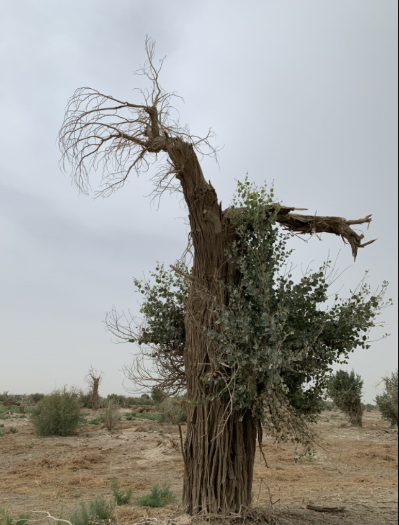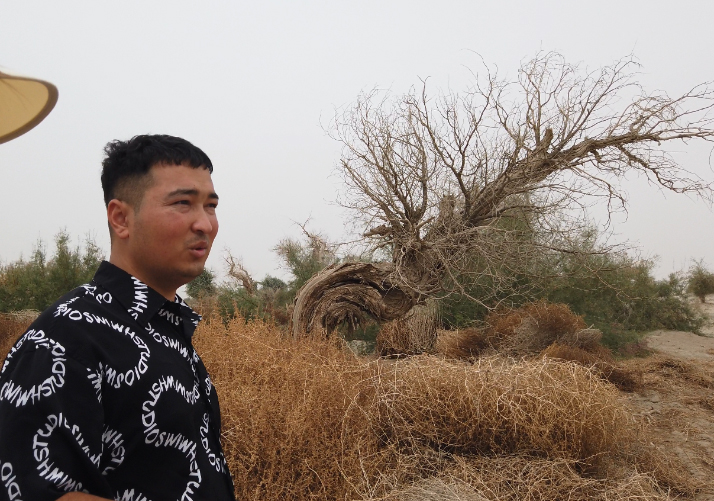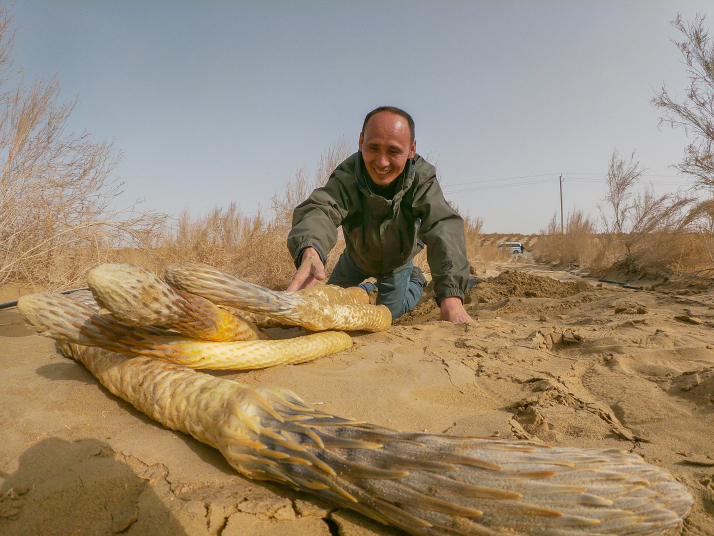| China |
| Xinjiang's battle against desertification pays off | |
|
|
 A poplar tree sprouts new leaves after being nourished by the Yarkant River's redirected water runoff (LI FANGFANG)
"I've heard about the legend that claims a desert poplar will stand tall for another 1,000 years after it dies. But I never expected to see them come back to life with my own eyes," Mawlan Mamat, a Uygur desert and forest ranger in Xinjiang Uygur Autonomous Region, told Beijing Review. Mamat's eyes lit up when talking about his first time seeing the withered Euphrates poplars beginning to sprout new leaves two years ago in the region's Taklamakan Desert, China's largest desert and the world's second largest shifting-sand one. For roughly three years, he has helped orchestrate the annual irrigation of the wild poplar tree forest at the Xiahe forestry farm in Bachu County, where wild poplar trees cover some 210,667 hectares, in an attempt to rehabilitate the area's fragile ecosystem. Locals there have long been living with the desert and the runoff of the Yarkant River is the main water source nurturing the area. But the seasonal river flows are extremely uneven—large flows occur in summer, with the volume in June, July and August accounting for more than 65 percent of the annual water volume, while smaller flows occur in winter. The Yarkant River basin is one of the main areas featuring Euphrates poplar forests in Xinjiang. However, in the river's lower reaches, these forests were parched for six decades because of excessive water consumption by agricultural development along the riverbanks. In 2016, local water resources departments launched an annual flood control project to divert the river's flow during the flood season to those dry areas. In 2022 alone, about 334 million cubic meters of water were delivered to the Yarkant River basin, nourishing more than 66,667 ha of Euphrates poplar forest. For Mamat, these poplar trees surviving in the desert embody a type of heroic spirit. No matter how difficult the ecological environment, they want to live. And when he saw his "heroes" restoring their former glory, Mamat felt proud to have contributed to their, and his homeland's, wellbeing.  Desert and forest ranger Mawlan Mamat at the Xiahe forestry farm in Bachu County, Xinjiang Uygur Autonomous Region, in July 2022 (LI FANGFANG)
Desertification controlled The color green has been popular with Xinjiangers since ancient times. It represents life and hope for them. The region's desert area covers a whopping 440,600 square km, accounting for 64 percent of China's overall desert area. "Xinjiang is one of the most seriously desertified areas in the world and it is extremely difficult to prevent and control desertification," Wang Yongdong, a senior ecological construction engineer with the Xinjiang Institute of Ecology and Geography under the Chinese Academy of Sciences, told Xinjiang Daily in December 2022. Every spring, people across the region, regardless of age or profession, are planting trees, particularly in the southern part of Xinjiang where the Taklamakan Desert covers most of the land. Most counties or villages there are scattered along the desert's edge. Therefore, from an early age on, locals receive education on water saving and tree planting. Liu Kang followed in the footsteps of his father, a man committed to his academic career revolving around afforestation and sand control, and became an expert in sand control. Having worked in the field for 36 years, 50-something Liu currently leads a related institute under the Xinjiang Academy of Forestry. "There are so many people in Xinjiang combating desertification; I'm just one of them," Liu told Workercn.cn, the website of the Workers' Daily, a national newspaper. In 1992, Liu began his research on the prevention of desertification in Hotan Prefecture, skirting the southern edge of the Taklamakan Desert. He found locals there diligently stuck to the tradition of creating strips of vegetation populated with trees and shrubs to fight back against sandstorms. The scholar then decided to turn the sand into a golden opportunity. Liu and his colleagues connected the existing shelterbelts to form a grid, with farmland sitting right in the middle. The shelter forest consisting of fruit trees protected the farmland from wind and sand as well as helped maintain a stable temperature around the wheat and cotton fields. This way, locals could make some extra money from their crops after volunteering to plant trees. In the 1990s, the use of a grid shelterbelt for the purposes of wind-breaking and sand-fixing was a rare sight in China, let alone one that had become a bonafide business. Twenty years later, Liu shifted his focus to the southern skirt of the Junggar Basin where China's second largest desert, the Gurbantünggüt Desert, locates. "In the past, we just planted trees and watered the ground, but now we emphasize sustainable development. The comprehensive management of the landscape, forest, farmland, lake, grass and sand is a whole system, and the entire ecosystem should be improved—all the while considering the economic benefits," Liu said.  Tian Ye, a retired soldier, digs up Roucongrong, dubbed the "ginseng of the desert" and the key element in a famous traditional Chinese herbal tonic. He combines his business of growing Roucongrong with planting drought-tolerant trees and shrubs in the desert in Xinjiang Uygur Autonomous Region (XINHUA)
Green is gold Today, more and more ordinary residents of and newcomers to Xinjiang are spotting business opportunities in the region's anti-desertification efforts. Tian Ye, a retired soldier, came across some Hotan farmers as they were planting trees in the desert in 2018. What impressed him most was that those farmers seemed to be enjoying their hard work. He realized that the Roucongrong, a cistanche herb dubbed the "ginseng of the desert" and the key element of a famous traditional Chinese herbal tonic, could be grown from the roots of the drought-tolerant Haloxylon, a genus of shrubs or small trees. Grafting the herbs onto the roots of sand-fixing plants can increase the plants' drought tolerance, according to research. Plus, growing the precious herb can also increase local income—100 grams of processed Roucongrong sells for about 150 yuan ($22.19) on some e-commerce platforms. As Chinese President Xi Jinping has pointed out on multiple occasions, in reference to China's path for green development: Green is gold. Tian's idea became a reality after seven more retired soldiers joined him and together they founded a startup to run this desert business. However, their journey wasn't an easy one. The most distressing obstacle they encountered was the extreme wind in spring 2021, which uprooted more than 13 hectares of saplings planted the previous year. "All the saplings that had survived disappeared in the sandstorms," Tian said. However, the veteran picked up a shovel, went into the sandy sea and started replanting. After nearly four years of development, they have planted more than 10 species of sand-fixing trees and shrubs in the desert, such as the Euphrates poplar and the rose willow, with a survival rate of more than 85 percent. The entrepreneurial experience of these veterans is a microcosm of Xinjiang's overall industrialization and desertification control. Compared with 2014, the area of desertified land in Xinjiang has decreased by 24,300 hectares. This is the first time the region has realized the overall reduction of desertified land, according to a press conference on the national desertification prevention and control plan on December 30, 2022. (Print Edition Title: Mission Possible) Copyedited by Elsbeth van Paridon Comments to ffli@cicgamericas.com |
|
||||||||||||||||||||||||||||
|